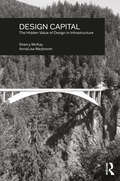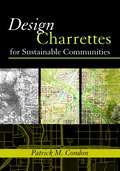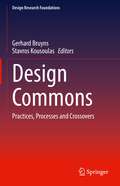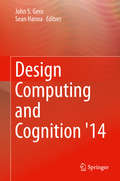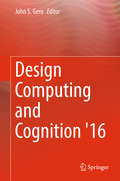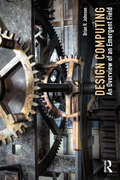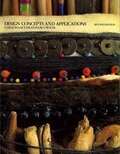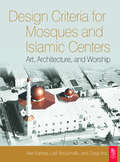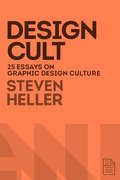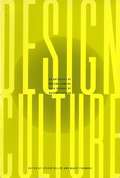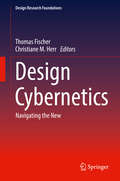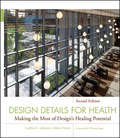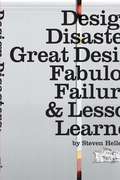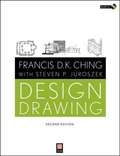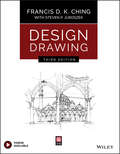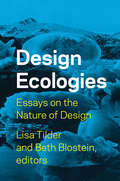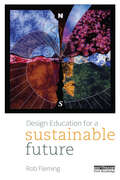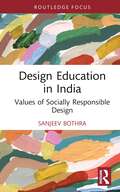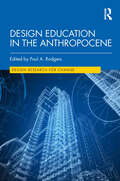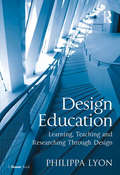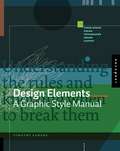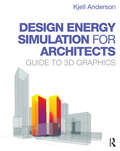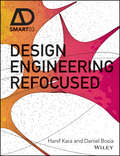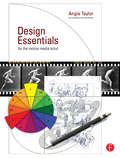- Table View
- List View
Design Capital: The Hidden Value of Design in Infrastructure
by AnnaLisa Meyboom Sherry McKayWell-designed infrastructure brings social value that far exceeds its initial construction expenditure, but competition for scarce government funds and a general public perception of infrastructure as mere efficiency, has often left design ill-considered. This book provides designers with the tools needed to argue for the value of design: the ‘design capital’ as the authors term it. In naming and defining design capital, design can once again become part of the discussion and realization of every infrastructure project. Design Capital offers strategies and tools for justifying public spending on design considerations in infrastructure projects. Design has the ability to make infrastructure resonate with cultural or social value, as seen in the case studies, which bestows infrastructure with the potential to accrue design capital. Support for this proposition is drawn from various methodologies of economic valuation and Bourdieu’s theory of cultural capital, explanation of design methodology and education and a series of historical and contemporary case studies. The book also addresses some of the more controversial outcomes associated with contemporary infrastructure: gentrification, globalization and consumer tourism. With this book, designers can make a stronger case for the value of design in public infrastructure.
Design Capital: The Hidden Value of Design in Infrastructure
by AnnaLisa Meyboom Sherry McKayWell-designed infrastructure brings social value that far exceeds its initial construction expenditure, but competition for scarce government funds and a general public perception of infrastructure as mere efficiency, has often left design ill-considered. This book provides designers with the tools needed to argue for the value of design: the ‘design capital’ as the authors term it. In naming and defining design capital, design can once again become part of the discussion and realization of every infrastructure project.Design Capital offers strategies and tools for justifying public spending on design considerations in infrastructure projects. Design has the ability to make infrastructure resonate with cultural or social value, as seen in the case studies, which bestows infrastructure with the potential to accrue design capital. Support for this proposition is drawn from various methodologies of economic valuation and Bourdieu’s theory of cultural capital, explanation of design methodology and education and a series of historical and contemporary case studies. The book also addresses some of the more controversial outcomes associated with contemporary infrastructure: gentrification, globalization and consumer tourism.With this book, designers can make a stronger case for the value of design in public infrastructure.
Design Charrettes for Sustainable Communities
by Patrick M. CondonA step-by-step guide to more synthetic, holistic, and integrated urban design strategies, Design Charrettes for Sustainable Communities is a practical manual to accomplish complex community design decisions and create more green, clean, and equitable communities. The design charrette has become an increasingly popular way to engage the public and stakeholders in public planning, and Design Charrettes for Sustainable Communities shows how citizens and officials can use this tool to change the way they make decisions, especially when addressing issues of the sustainable community. Designed to build consensus and cooperation, a successful charrette produces a design that expresses the values and vision of the community. Patrick Condon outlines the key features of the charrette, an inclusive decision-making process that brings together citizens, designers, public officials, and developers in several days of collaborative workshops. Drawing on years of experience designing sustainable urban environments and bringing together communities for charrettes, Condon's manual provides step-by-step instructions for making this process work to everyone's benefit. He translates emerging sustainable development concepts and problem-solving theory into concrete principles in order to explain what a charrette is, how to organize one, and how to make it work to produce sustainable urban design results.
Design Commons: Practices, Processes and Crossovers (Design Research Foundations)
by Gerhard Bruyns Stavros KousoulasThis book directly links the notion of the commons with different design praxes, and explores their social, cultural, and ecological ramifications. It draws out material conditions in four areas of design interest: social design, commons and culture, ecology and transdisciplinary design. As a collection of positions, the diversity of arguments advances the understanding of the commons as both concepts and modes of thinking, and their material translation when contextualised in the domain of design questions. In other words, it moves abstract social science concepts towards concrete design debates. This text appeals to students, researchers and practitioners working on design in architecture, architecture theory, urbanism, and ecology.
Design Computing and Cognition '14
by John S. Gero Sean HannaThis book details the state-of-the-art of research and development in design computing and design cognition. It features more than 35 papers that were presented at the Sixth International Conference on Design Computing and Cognition, DCC'14, held at University College, London, UK. Inside, readers will find the work of expert researchers and practitioners that explores both advances in theory and application as well as demonstrates the depth and breadth of design computing and design cognition. This interdisciplinary coverage, which includes material from international research groups, examines design synthesis, design cognition, design creativity, design processes, design theory, design grammars, design support and design ideation. Overall, the papers provide a bridge between design computing and design cognition. The confluence of these two fields continues to build the foundation for further advances and leads to an increased understanding of design as an activity whose influence continues to spread. As a result, the book will be of particular interest to researchers, developers and users of advanced computation in design and those who need to gain a better understanding of designing that can be obtained through empirical studies.
Design Computing and Cognition '16
by John. S GeroThis book gathers the peer-reviewed and revised versions of papers from the Seventh International Conference on Design Computing and Cognition (DCC'16), held at Northwestern University, Evanston (Chicago), USA, from 27-29 June 2016. The material presented here reflects cutting-edge design research with a focus on artificial intelligence, cognitive science and computational theories The papers are grouped under the following nine headings, describing advances in theory and applications alike and demonstrating the depth and breadth of design computing and design cognition: Design Creativity; Design Cognition - Design Approaches; Design Support; Design Grammars; Design Cognition - Design Behaviors; Design Processes; Design Synthesis; Design The book will be of particular interest to researchers, developers and users of advanced computation in design across all disciplines, and to all readers who need to gain a better understanding of designing.
Design Computing: An Overview of an Emergent Field
by Brian R. JohnsonDesign Computing will help you understand the rapidly evolving relationship between computing, designers, and the many different environments they create or work in. The book introduces the topic of design computing, and covers the basics of hardware and software, so you don’t need to be an expert. Topics include the fundamentals of digital representation, programming and interfaces for design; the shifting landscape of opportunity and expectation in practice and pedagogy; placing sensors in buildings to measure performance; and the challenge of applying information effectively in design. The book also includes additional reading for those who wish to dig deeper into the subject. Design Computing will provide you with a greater awareness of the issues that permeate the field, opportunities for you to investigate, and perhaps motivation to push the boundaries.
Design Concepts and Applications
by Frank R. Cheatham Jane Hart Cheatham Sheryl Haler OwensDesign Concepts and Applications
Design Criteria for Mosques and Islamic Centres
by Akel Kahera Latif Abdulmalik Craig AnzThe design principles necessary to create functional and dynamic contemporary mosques can be hard to grasp for those unfamiliar with the Islamic faith. 'Design Criteria for Mosques and Islamic Centers' provides an easy-to-use and practical set of guidelines for mosque design, illustrated with 300 line drawings. Case studies of urban mosques in New York, Washington, Boston, and London and Birmingham amongst others, demonstrate how mosques and Islamic centers have evolved to integrate into the urban scenario. The book also compares tenets from Western and Eastern religious and secular philosophies and discusses their relation to architectural creation, place-making, meaning, and identity. The book shows how mosques fulfill multiple faith-based and social roles through their design; it provides a wide-ranging, basic understanding of Islamic liturgical conventions and secular functions to enable architects, designers, and community advocates to work with confidence. 'Design Criteria for Mosques and Islamic Centers' is the first dedicated design guide for mosques and Islamic centers available. • Features case studies from the USA, UK, and Europe• Explains fundamental principles to make it easy to create viable design solutions for these exacting buildings that fulfi ll a range of social and religious roles.
Design Cult
by Steven HellerRenowned designer, author, critic, co-chair of SVA's MFA program in design and National Design Award recipient Steven Heller reaches into the most contemplative recesses of his mind to offer an entertaining new collection of ruminations on the nature and future of design. In Design Cult-the first of a series of three titles published exclusively as e-books through the DesignFile consortium-Heller expounds on such disparate topics as Milton Glaser, Japanese masks, velvet touch lettering, anthropomorphism and people in glass apartments.DesignFile is the new line of e-books on topics and trends in design published by the Cooper-Hewitt, Smithsonian Design Museum. There will be six to twelve titles published annually, each ranging in length from 7,500 to 20,000 words. Building a consortium with institutional partners and design practitioners, Cooper-Hewitt's series will bridge the academic, museum, design, and publishing worlds. Inaugural members of the e-book consortium are Parsons The New School for Design and the School of Visual Arts.
Design Culture: An Anthology of Writing from the AIGA Journal of Graphic Design (Designfile Ser.)
by Steven Heller Marie FinamorePresenting a significant selection of seventy-eight essays, interviews, and symposia from the pioneering AIGA Journal of Graphic Design, Design Culture examines the coming of age of graphic design as a profession and its role in shaping our culture. A diverse group of leading designers, editors, academics, and professionals both within and outside the field offer stimulating views on the impact of graphic design on everyday life. Topics range from skateboard graphics to the NASA logo to Lucky Charms cereal, and are grouped under ten intriguing chapter headings, including: Love, Money, Power; Facts and Artifacts; Modern and Other Isms; Design 101; Public Works; Understanding Media; and Future Shocks. Design Culture brings new meaning to design issues for anyone interested in contemporary culture. Essays by: Philip B. Meggs, Fath Davis Ruffins, Natalia Ilyin, Rosemary Coombs, Steven Heller, Paula Scher, Rick Poynor, Michael Bierut, Lorraine Wild, Ellen Lupton, Paul Rand, Jeffery Keedy, Peter Fraterdeus, Gunar Swanson, Roy Behrens, Veronique Vienne, Paul Saffo, Jessica Helfand, Robin Kinross, Milton Glaser, Michal Rock, Ellen Shapiro, and many more. Co-published with the American Institute of Graphic Arts.
Design Cybernetics: Navigating the New (Design Research Foundations)
by Thomas Fischer Christiane M. HerrDesign Cybernetics: Navigating the New Design cybernetics offers a way of looking at ourselves – curious, creative, and ethical humans – as self-organising systems that negotiate their own goals in open-ended explorations of the previously unknown. It is a theory of and for epistemic practices (learning, designing, researching) that is deeply committed to the autonomy of others and hence offers no prescriptive methodology. Design cybernetics describes design practice as inextricable from conversation – a way of enquiring, developing shared understanding and reaching the new that harnesses reliable control as well as error and serendipity. Recognising circular causality, observer-dependency and non-determinability, design cybernetics extends beyond tenets of scientific research into the creative, ethical and aesthetic domain. From this perspective, design is not an ill-conceived subset of scientific research. Instead, scientific research emerges as a particularly restricted subset of the broader human activity of design. This volume offers a cross-section of design cybernetic theory and practice with contributions ranging across architecture, interior lighting studies, product design, embedded systems, design pedagogy, design theory, social transformation design, research epistemology, art and poetics, as well as theatre and acting. Addressing designers, design educators and researchers interested in a rigorous, practice-based epistemology, it establishes design cybernetics as a foundational perspective of design research. “This is a conceptually elegant, well structured, and comprehensive presentation of design cybernetics. It fills a gap in the literature of the field.” Ken Friedman, Chair Professor, Tongji University “This book offers a valuable and timely introduction to second-order cybernetics as society grapples with complex issues like climate change and rising inequality.” Joichi Ito, Director of the MIT Media Lab
Design Details for Health
by Cynthia Leibrock Debra D. HarrisThe revised edition on implementing design details to improve today's health care facilities-an inspiring, comprehensive guide In this significantly revised second edition, Cynthia Leibrock and Debra Harris offer up-to-date information on design details that can improve patient outcomes and user experience by returning authority to the patient, along with fascinating case studies and research demonstrating the positive role design can play in reducing health care costs. Design Details for Health, Second Edition offers contemporary examples showing how design can improve patient comfort and independence, and demonstrates how to design highly functional health care facilities that operate at peak performance. The book addresses a range of health care facility types including hospitals, ambulatory care, wellness centers, subacute care and rehabilitation, adult day care and respite, assisted living, hospice, dementia care, and aging in place. This Second Edition includes: The latest research, which was only anecdotal in nature as recently as a decade ago, illustrating how design through evidence produces measurable outcomes Real-world case studies of a range of excellent health care facilities that have been designed and built in the twenty-first century Updated contributions with leading practitioners, researchers, and providers conveying how design has a positive impact on health care delivery When design empowers rather than disables, everybody wins. Sensitive to the needs of both patients and providers, Design Details for Health, Second Edition is essential reading for today's architects, interior designers, facility managers, and health care professionals.
Design Disasters: Great Designers, Fabulous Failure, and Lessons Learned
by Steven HellerThe thrill of victory...the agony of defeat. We're not talking about just any failure. Design failure. So public. So humiliating. How do designers who are really, really good (we swear!) turn a disaster into a triumph? Read this book and find out, as dozens of top names reveal the heartbreaking-and sometimes hilarious-mistakes they have made and talk about how they were able to grow from the experiences. Self-delusion, overcommitment, procrastination...they're all here. Poor communication, missed deadlines, enraged clients...yes, they're here too. Read Design Disasters and weep? No! Read Design Disasters and be inspired to find the silver lining in even the cloudiest situation.Featuring essays by: Henry Petroski Alissa Walker David Barringer Allan Chocinov Peter Blegvad Ross MacDonald Robert Grossman Ina Saltz Warren Lehrer Rob Trostle Ralph Caplan Richard Saul Wurman Marian Bantjes Rick Meyerowitz Amanda Bowers David Jury Veronique Vienne Francis Levy Colin Berry Nick Curry Debbie Millman, and more!
Design Drawing
by Francis D. Ching Steven P. JuroszekGet the completely revised edition to mastering the visual language of architecture.In his distinctive graphic style, world-renowned author and architecture educator Francis D.K. Ching takes us on another exciting journey through the process of creation. In Design Drawing, Second Edition, he unmasks the basic cognitive processes that drive visual perception and expression, incorporating observation, memory, and rendering into a creative whole. This edition unites imaginative vision with fundamental architectural principles to cover the traditional basics of drawing, including line, shape, tone, and space. Guiding the reader step-by-step through the entire drawing process, Design Drawing also examines different types of drawing techniques such as multiview, paraline, and perspective drawings -- and how they can be applied to achieve stunning results. In addition, this edition:Goes beyond basic drawing books--Ching not only covers the principles, media, and techniques of drawing, but also places these within the context of what and why designers draw.Features more than 1,500 hand-rendered drawings--beautiful illustrations that reinforce the concepts and lessons of each chapter.Includes a supplemental CD-ROM--viewers will gain a greater appreciation of the techniques presented in this book through the power of animation, video, and 3D models. Twelve new modules are included, as is a video of the author demonstrating freehand techniques in a step-by-step manner.For professional architects, designers, fine artists, illustrators, teachers and students alike, this all-in-one package is both an effective tool and an outstanding value, demonstrating concepts and techniques in a visually stimulating format that transends comparable works in the field.
Design Drawing (Architecture Ser.)
by Francis D. ChingTHE CLASSIC GUIDE TO DRAWING FOR DESIGNERS, REVISED AND UPDATED TO INCLUDE CURRENT DIGITAL-DRAWING TECHNIQUES Hand drawing is an integral part of the design process and central to the architecture profession. An architect's precise interpretation and freedom of expression are captured through hand drawing, and it is perhaps the most fundamental skill that the designer must develop in order to communicate thoughts and ideas effectively. In his distinctive style, world-renowned author Francis D. K. Ching presents Design Drawing, Third Edition, the classic guide to hand drawing that clearly demonstrates how to use drawing as a practical tool for formulating and working through design problems. While digital tools continue to evolve, this Third Edition includes new illustrations and information on the latest digital-drawing techniques. Design Drawing, Third Edition covers the basics of drawing, including line, shape, tone, and space. Guiding the reader step-by-step through the entire drawing process, this Third Edition also examines different types of drawing techniques such as multiview, paraline, and perspective drawings—and reveals how the application of these techniques creates remarkable results. In addition, Design Drawing, Third Edition: Features over 1,500 hand drawings—stunning illustrations in the author's signature style that reinforce the concepts and lessons of each chapter Offers new exercises and illustrative examples that range in complexity Presents all-new digital drawing topics, such as hybrid floor plans, digital models and fabrication, and hand-to-digital fluency Includes access to a new website featuring videos of the author demonstrating freehand techniques in a step-by-step manner in the studio and on location Includes access to a brand new website (Francis Ching (wiley.com)) featuring videos of the author demonstrating freehand techniques in a step-by-step manner in studio and on location. Readers will gain a greater appreciation of the techniques presented in the book through the power of animation, video, and 3D models Written and illustrated for professional architects, designers, fine artists, illustrators, instructors and students, Design Drawing, Third Edition is an all-in-one package and effective tool that clearly demonstrates drawing concepts and techniques in a visually stimulating format that outshines other works in the field.
Design Ecologies: Essays on the Nature of Design
by Lisa Tilder Beth BlotsteinContemporary architects are under increasing pressure to offer a sustainable future. But with all the focus on green building there has been little investigation into the meaningful connections between architectural design, ecological systems, and environmentalism. A new generation of architects, landscape architects, designers, and engineers aims to recalibrate what humans do in the world according to how the world works as a biophysical system. Design in this sense is a larger concept having to do as much with politics and ethics as with aesthetics and technology. This recasting of the green movement for the twenty-first century transforms design into a positive agent balancing societal values with environmental needs.Design Ecologies is a ground-breaking collection of never-before-published essays and case studies by today's most innovative designers and critics. Their design strategies—social, material, and biological—run the gamut from the intuitive to the highly technological. One essay likens window-unit air conditioners in New York City to weeds in order to spearhead the development of potential design solutions. Latz + Partner's Landscape Park integrates vegetation and industry in an urban park built amongst the monumental ruins of a former steelworks in Duisburg Nord, Germany. The engineering firm Arup presents its thirty-three-square-mile masterplan for Dongtan Eco City, an energy-independent city that China hopes will house half a million people by 2050. An essay by designer Bruce Mau leads off a stellar list of emerging designers, including Jane Amidon, Blaine Brownell, David Gissen, Gross.Max, Robert Sumrell and Kazys Varnelis, Stephen Kieran and James Timberlake, R&Sie(n), Studio 804, and WORKac.
Design Education for a Sustainable Future
by Rob FlemingSustainability is a powerful force that is fundamentally reshaping humanity’s relationship to the natural world and is ushering in the Age of Integration. The move from well-intentioned environmental friendliness to the higher bar of integral sustainability and regenerative design demands a new type of design professional, one that is deeply collaborative, ethically grounded, empathically connected and technologically empowered. As a response, this book argues for a great leap forward in design education: from an individualistic and competitive model casually focused on greening; to a new approach defined by an integral consciousness, shaped by the values of inclusivity and cooperation, and implemented by a series of integrative behaviors including: an ethically infused design brief a co-creative design process on-going value engineering pre-emptive engineering design validation through simulation on-line enabled integrated learning the use of well vetted rating systems. This book contains the integral frameworks, whole system change methodologies and intrinsic values that will assist professors and their students in an authentic and effective pursuit of design education for a sustainable future.
Design Education in India: Values of Socially Responsible Design (Routledge Research in Social Design)
by Sanjeev BothraThis book traces developments in design education in India and shows the continuing impact of the Bauhaus School of design education, which formed the basis of the National Institute of Design. It presents the findings of the author's research and experiential learning as a design educator over a 25-year period. This book argues that as the effects of climate change and the exploitation of natural and human resources become more pervasive, it has become increasingly important to ensure that the values of social responsibility are instilled into the design students who will become future practitioners. This book offers an alternative model of understanding regarding the ecosystem of design and sustainable design education. Going beyond description and analysis, it includes three case studies of adoptable design curricula created by the author, with student responses to the programmes to provide first-hand insights into their impact. Research findings are based on detailed interviews with contemporary faculty members, all experts in the various design disciplines, along with an in-depth survey of existing design programmes in India. Design Education in India encourages a paradigm shift in thinking about the environment, spaces and places. It offers a unique perspective on the status of design education in an important and fast-growing economy and will be a useful read for design educators and researchers in varied disciplines.
Design Education in the Anthropocene (Design Research for Change)
by Paul A. RodgersThis volume examines emerging practice and research in design education rooted in the context of significant global issues.A diverse set of international contributors present novel design education research that seeks to make significant social, economic, cultural and environmental change. Topics covered include fashion, sustainability, creativity, social justice, museum education, climate change, environmentalism, and empathy. The chapters draw a link between current research practice and theory and future challenges for the field.The book will be of interest to scholars working in communication design, graphic design, design research, and information design.
Design Education: Learning, Teaching and Researching Through Design
by Philippa LyonEmbracing the richness, complexity and possibilities of learning and teaching in design, Design Education takes the vantage point of the 'outsider' and explores what makes design so compulsively fascinating for those who teach and study it. Through more than 40 projects, from design students' use of archives and museum collections to the potential of specific technologies to enhance teaching and learning, from architecture and 3D design to fashion, Philippa Lyon explores aspects of learning and teaching in higher education design subjects. Taking an ethnographic approach and using data from interviews, discussions and observations, the book also examines issues such as the experience of design teacher-practitioners entering the world of learning and teaching research for the first time. Design Education encapsulates and analyzes the research findings facilitated by the UK-based Centre for Excellence in Teaching and Learning Through Design. It delves into many pedagogical terms and assumptions and guides the reader through them, examining the way relevant key concepts in design are articulated. It will be useful to teachers and students of design subjects, learning and interpretation staff in museums, pedagogical researchers, other centres for excellence in teaching and learning (particularly those which are art and design-related), independent design practitioners and managers of art and design provision in the public and private sector.
Design Elements: Understanding the Rules and Knowing When to Break Them
by Timothy SamaraThis book is a compact and lucid handbook outlining the basic principles of layout, typography, color usage and space.
Design Energy Simulation for Architects: Guide to 3D Graphics
by Kjell AndersonLeading architectural firms are now using in-house design simulation to help make more sustainable design decisions. Taking advantage of these new tools requires understanding of what can be done with simulation, how to do it, and how to interpret the results. This software-agnostic book, which is intended for you to use as a professional architect, shows you how to reduce the energy use of all buildings using simulation for shading, daylighting, airflow, and energy modeling. Written by a practicing architect who specializes in design simulation, the book includes 30 case studies of net-zero buildings, as well as of projects with less lofty goals, to demonstrate how energy simulation has helped designers make early decisions. Within each case study, author Kjell Anderson mentions the software used, how the simulation was set up, and how the project team used the simulation to make design decisions. Chapters and case studies are written so that you learn general concepts without being tied to particular software. Each chapter builds on the theory from previous chapters, includes a summary of concept-level hand calculations (if applicable), and gives comprehensive explanations with graphic examples. Additional topics include simulation basics, comfort, climate analysis, a discussion on how simulation is integrated into some firms, and an overview of some popular design simulation software.
Design Engineering Refocused (AD Smart)
by Hanif Kara Daniel BosiaThe contents of the book will highlight the differences between the design and engineering disciplines – strengths and flaws. It will also illustrate examples of interdisciplinary interactions. Any false dichotomies will be revealed and the many non-linear processes borne out of challenging conventions between traditional and new modes of practice will be revealed. Projects based on a body of experience spanning many years will be selected to support experimentation that goes beyond an undisciplined search for originality, innovation and creativity. In addition to writings from Hanif Kara and Daniel Bosia contributions will be sought from specialists in the field who have played a role in the operations of P.art® at AKT II – past and present – qualifying them to disseminate and distribute a particular form of ‘knowledge’. Features work of architectural practices: Adjaye Associates, Foster + Partners, Heatherwick Studio, HOK, Serie Architects, Wilkinson Eyre Architects and Zaha Hadid Architects. In addition to AKT II, it will encompass the work of engineers and engineering consultants such as: Arup, Cecil Balmond, Buckminster Fuller, Buro Happold, Pier Luigi Nervi and Peter Rice.
Design Essentials for the Motion Media Artist: A Practical Guide to Principles & Techniques
by Angie TaylorMaster the fundamental concepts and techniques of motion media design so you can apply--and occasionally break--the rules to achieve your communication goals. This authoritative guide presents all of the design essentials in an engaging and inspiring way. Each principle is explained with text, illustration and photography where necessary. An accompanying website will contain any necessary digital files for download, updates and links to other resources.
